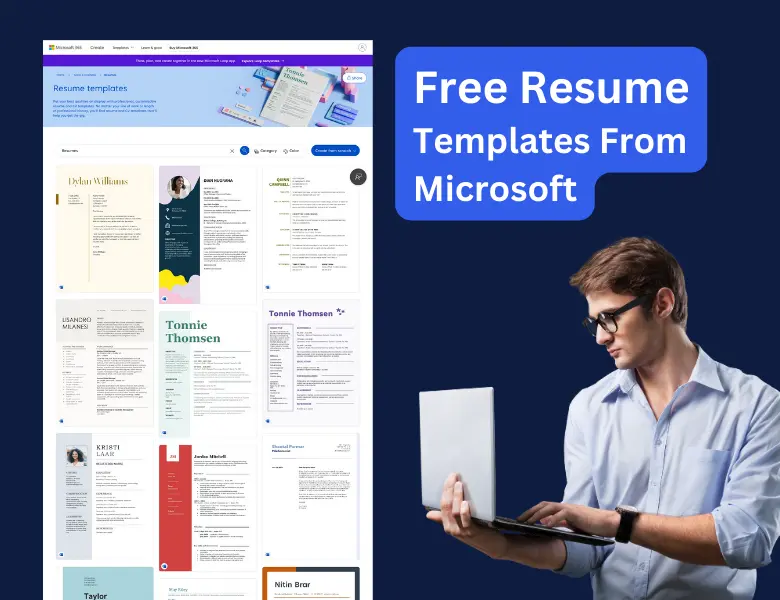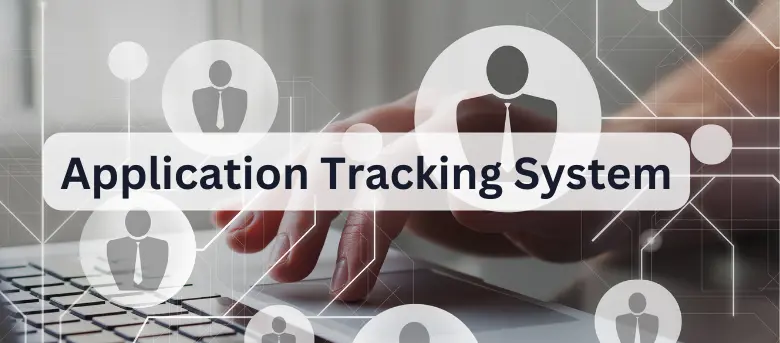In today’s competitive job market, having a standout resume is more important than ever. This comprehensive guide will show you how to create a professional and eye-catching resume using Microsoft Word. Whether you’re a seasoned professional or a newcomer to the workforce, you’ll find valuable insights into selecting the right template, formatting your resume, and tailoring it to your career goals. Discover why this article is a must-read for anyone serious about making a great first impression on potential employers.
Why Microsoft Word is Great for Your Resume?
Microsoft Word has many features that help you make a good-looking and professional resume. It’s easy to use and has lots of templates to choose from, making it a popular choice for making resumes. Most employers like to get resumes in Microsoft Word format, so it’s a common choice. Also, since many people know how to use it, it’s easier to start making your resume without learning a new program.
Some of the reasons to make a resume in Microsoft Word are:
Extensive Template Library:
Microsoft Word boasts a comprehensive collection of resume templates suitable for various professions and experience levels. This extensive library offers a solid foundation for starting your resume, ensuring it has a professional and appealing layout from the start.
User-Friendly Interface:
Even for those less familiar with advanced software, Word’s intuitive interface makes it easy to create and edit resumes. Its straightforward design allows users to focus on content rather than struggling with complicated formatting.
Advanced Customization Options:
Word enables extensive customization of templates. Users can easily adjust fonts, colours, and layouts to tailor their resume to their style and the job they’re applying for. This flexibility is key to creating a resume that stands out while remaining professional.
Wide Compatibility and Easy Sharing:
Resumes created in Word are widely compatible and easy to share. They can be saved in various formats, like PDF, ensuring they retain their formatting across different devices and platforms. This compatibility is essential for ensuring your resume appears as intended to potential employers.
Robust Formatting and Editing Tools:
Word offers a suite of formatting tools that help in creating a clear, concise, and attractive resume. From bullet points and line spacing to customizable headers and footers, these tools aid in effectively organizing and presenting your professional information.
How to Make a CV in Microsoft Word Format?
Creating a resume that catches the eye of recruiters involves more than just listing your experiences and skills; it’s also about how you present this information. Effective formatting is key to making your resume visually appealing and easy to read. Here’s a step-by-step guide to help you create a standout resume using Microsoft Word.
Step-by-Step Guide On How To Make Your Resume in Microsoft Word From Scratch

Step 1: Choosing the Right Template
- Open Microsoft Word: Start by launching the MS Word application on your computer.
- Browse Templates: To access a variety of resume templates, either select a template directly within Microsoft Word by clicking on ‘File’ and then ‘New,’ or visit https://create.microsoft.com/en-us/templates/resumes to download a template of your choice. In Microsoft Word, you can find free templates by clicking on ‘File’ and ‘New,’ where you can choose from available options or search for more using the “resume” keyword in the search bar.
- Selecting a Template: Pick a template that aligns with your industry and the job you’re applying for. Creative fields might prefer more visually dynamic templates, while traditional industries might favour classic, streamlined designs.
- Template Customization: Once you’ve decided on a template, click on it to open a new document. This template will serve as the base for your resume.
Step 2: Customizing Your ms word resume Templates
- Personalize the Design: Modify colours, fonts, and layout to fit your style. However, the best way to create a resume is to keep it professional. Avoid overly bright colours or hard-to-read fonts.
- Adjusting Sections: Depending on your experience and skills, in creating your resume you might want to add or remove sections from the template. For example, if you have extensive work experience, make sure there’s enough space to list it all.
- Setting Up Your Document: If not using a template, set your page layout. Go to ‘Layout’ → ‘Size’ and select A4 or US Letter. Adjust margins for a balanced look by going to ‘Layout’ → ‘Margins’. Standard margins are around 1 inch.
Step 3: Inputting Your Information on your resume
- Contact Information: Start by entering your name, phone number, email, and LinkedIn profile (if applicable) at the top of the resume.
- Resume Objective or Summary: Write a concise objective or summary that reflects your career goals and highlights your key skills. This should be tailored to each job application.
- Work Experience: List your job experience in reverse chronological order, starting with your most recent job. Include your job title, company name, dates of employment, and a brief description of your responsibilities and achievements.
- Educational Background: Include your highest level of education, the institution’s name, and the years attended. You can also add any relevant courses or certifications.
- Skills: Add a section for skills relevant to the job you’re applying for. This could include technical skills, languages, or soft skills.
Step 4: Formatting Your Resume
- Fonts and Sizes: Choose a professional font like Arial, Calibri, or Times New Roman. Keep the font size between 10-12 points for readability.
- Bullet Points: Use bullet points to list your responsibilities and achievements. This makes the resume easier to scan.
- Margins and Spacing: Standard margins are 1 inch on all sides. Make sure there’s adequate spacing between sections for readability.
Step 5: Reviewing and Editing
- Proofread: Carefully proofread your resume for any spelling or grammar errors. Using Grammarly for spell check and grammar for proofreading.
- Feedback: If possible, send your CV to get feedback on your resume from a mentor or a colleague. They might provide valuable insights or catch errors you missed.
Step 6: Saving and Exporting Your Resume
- Saving in Word Format: Save your resume in Word format (.doc or .docx) for future editing.
- Exporting as PDF: For submission, it’s often recommended to save your resume as a PDF. This preserves the formatting across different devices. Go to ‘File’, then ‘Save As’, and choose ‘PDF’ from the file format options.
Step 7: Regular Updates
Keep It Updated: Regularly revisit your resume to update it with new skills, experiences, or certifications. This ensures it remains relevant for future job applications.
By following these steps, you can create a perfect resume on Microsoft Word. Remember, your resume is your marketing tool, so take the time to make it reflect your best professional self.
What is an Application Tracking System and What are ATS-friendly Free Resume Templates in Word

ATS System
An Applicant Tracking System (ATS) is a type of software used by employers during the hiring process. It helps in managing and organizing large volumes of job applications. The primary functions of an ATS include:
- Resume Screening: ATS systems are programmed to scan and rank resumes based on specific criteria set by the employer, such as keywords, skills, former employers, years of experience, and education.
- Applicant Sorting: It sorts applicants based on the relevancy of their background to the job requirements.
- Tracking and Communication: It keeps track of applicants through different stages of the hiring process and can be used to communicate with candidates.
ATS-Friendly Resume Templates
When creating a resume intended to be ATS-friendly, certain template characteristics should be considered:
Simple, Clean Formatting:
- Use a straightforward layout.
- Avoid using tables, columns, or other complex formatting as they can confuse the ATS.
- Stick to traditional fonts like Arial, Times New Roman, or Calibri.
Standard Headings:
Use conventional heading titles like “Work Experience,” “Education,” and “Skills.” Avoid creative titles that the ATS might not recognize.
Keyword Optimization:
- Include keywords from the job description. These should be integrated naturally into the content of your resume.
- No Graphics or Images: Avoid using images, graphics, or logos. Text in these formats can’t be read by most ATS systems.
- File Type: Save your resume as a Word document (.doc or .docx) or a plain-text file (.txt) for maximum compatibility. Some ATS systems can also process PDFs, but this can be less reliable.
Avoid Headers and Footers:
Important information in headers and footers might not be scanned by the ATS. Avoid placing any important text in headers and footers, as ATS systems may not parse this information correctly. Additionally, maintain one-inch margins on all sides of your resume. Keeping these margins free from text enhances readability, making your resume more accessible for both ATS systems and human reviewers.
By adhering to these guidelines, your resume is more likely to be successfully parsed and understood by an ATS, increasing your chances of making it through the initial screening phase. Remember, though, the goal is not just to pass the ATS but also to impress the human recruiters who will read your resume afterwards. Therefore, balancing ATS-friendly formatting with human readability is key.
What are the top 5 mistakes to avoid while writing your resume for ATS systems?
Complex Formatting and Layout:
Avoid using tables, columns, or other intricate formatting elements. ATS systems can have difficulty parsing information from these complex structures, potentially leading to misinterpretation or omission of important details.
Embedding Key Information in Headers and Footers
Refrain from placing essential information like contact details in headers and footers. Many ATS systems do not scan these areas, which could result in your contact information being overlooked.
Using Non-Standard Fonts and Excessive Design Elements
Stick to standard, professional fonts and minimize design flair. Creative fonts and heavy design elements may not be processed correctly by an ATS, causing important content to be lost or misread.
Failing to Optimize with Relevant Keywords
Neglecting to include specific keywords and phrases from the job description. ATS systems are designed to scan for these keywords to determine the relevance of an applicant’s resume to the job opening.
Saving in Incompatible File Formats
Avoid using file formats that are not ATS-friendly. While PDFs are generally safe, some ATS systems handle them better than others. To be safe, use a Word document format (.doc or .docx), which is typically the most compatible with ATS software.
By avoiding these mistakes, you can increase the likelihood that your resume will be successfully parsed and considered by an ATS, thereby improving your chances of moving forward in the application process.
Frequently Asked Questions To Make a Resume in Word
How can I create a CV in Word?
Creating a CV (Curriculum Vitae) in Microsoft Word is a straightforward process, thanks to its user-friendly interface and number of templates. Here’s a step-by-step guide to help you make a professional CV in Microsoft Word:
To create a CV in Microsoft Word, follow these steps:
- Open Microsoft Word and choose ‘New’ from the ‘File’ menu.
- Search for ‘CV’ or ‘Resume’ in the templates search box.
- Select a template that suits your needs and click ‘Create’.
- Replace the placeholder text with your information. Focus on your work experience, education, skills, and achievements.
- Customize the design as needed — adjust fonts, colours, and layout.
- Proofread your CV thoroughly.
- Save your CV in Word format for editing and in PDF format for sending to employers.
How to write a resume example?
[Your Name]
Contact Information:
Address: [Your Address]
Phone: [Your Phone Number]
Email: [Your Email Address]
LinkedIn: [Your LinkedIn Profile URL]
Objective/Summary:
[A brief statement summarizing your professional goals and what you bring to the table. Tailor this to the specific job or field you’re targeting.]
Education:
[Degree], [Field of Study], [University Name], [Year of Graduation]
[Any relevant honours, scholarships, or academic achievements]
Work Experience:
[Job Title] – [Company Name], [Location] | [Start Date] – [End Date]
[Brief description of your role and responsibilities]
[Achievement or task 1, quantifying the impact if possible]
[Achievement or task 2, with details]
[Previous Job Title] – [Company Name], [Location] | [Start Date] – [End Date]
[Responsibilities and significant contributions]
[Notable achievement or project]
Skills:
[Skill 1: Detail your proficiency level or experience]
[Skill 2: Mention any certifications or accolades]
[Skill 3: Include technical, soft, or language skills as relevant]
Certifications and Additional Training:
[Certification Name], [Issuing Organization], [Year]
[Course or Training], [Provider], [Year]
Languages:
[Language]: [Proficiency Level]
Volunteer Experience/Extracurricular Activities:
[Activity or Role], [Organization], [Duration]
[Brief description of your role and impact]
References:
Available upon request.
Tips:
Customize the CV for the specific job or industry.
Keep the design clean and professional.
Use bullet points for clarity.
Be concise but provide enough detail to showcase your skills and achievements.
Proofread for grammar and spelling errors.
Ensure your contact information is up-to-date.
This CV format provides a comprehensive view of your professional profile, making it easy for potential employers to assess your suitability for the position.
Is there a CV template in Microsoft Word?
Indeed, Microsoft Word does offer a selection of CV templates. To access them, open Word, click on ‘File,’ choose ‘New,’ and search for ‘CV’ or ‘Resume’ in the templates search box. Alternatively, you can explore a variety of CV templates at https://create.microsoft.com/en-us/templates/resumes. These templates provide a structured layout, simplifying the process of creating a professional-looking CV. Once you’ve chosen a template, customize it with your personal information, experiences, and skills.
Is the CV supposed to be in Word or PDF?
When submitting a CV, the choice between a PDF and Word can depend on a few factors, but PDF is generally preferred. Here’s why:
PDF Format
- Consistency: PDFs maintain the formatting and layout regardless of the device or software used to view them. This ensures that your CV looks the same on every computer, which is crucial for maintaining a professional appearance.
- Universally Accessible: Almost every device and operating system can open a PDF, making it universally accessible.
- Prevents Unintended Editing: PDFs cannot be easily altered, which helps prevent any accidental changes to your CV.
Word Format
- Editable: Useful if the employer specifically asks for a Word document so they can make notes or changes.
- ATS-Friendly: Some Applicant Tracking Systems (ATS) parse Word documents more effectively than PDFs, although most modern ATS can handle PDFs well.
Considerations:
- Employer’s Preference: Always follow the employer’s instructions on CV format. If they specify Word, use Word; if they don’t specify, PDF is a safe bet.
- Industry Norms: In certain industries, like graphic design, a PDF might be preferred to preserve the visual layout and design.
In most cases, sending your CV as a PDF is the safer option, as it ensures that your formatting remains intact and presents your information as intended. However, always be prepared to provide your CV in different formats according to the specific requirements of the job application or employer preferences.
A Final Overview – Create Your Word CV
Wrapping Up: Crafting a Standout Resume with Microsoft Word
To wrap things up, let’s revisit the key steps for creating your CV using Microsoft Word:
- Selecting an Ideal Template: Begin by choosing from Microsoft Word’s array of free resume online templates, suited to different professional needs and styles.
- Personalization is Key: Customize your chosen template to reflect your brand. Tweak the layout, headings, and fonts to make it uniquely yours.
- Content is Crucial: Make a resume in Word with pertinent information like work experience, job titles, and a concise objective. Align your content with the specific job description for greater relevance.
- Clarity Through Bullet Points and Headings: Utilize bullet points for concise points and clear headings for easy navigation through your resume.
- Compatibility with Applicant Tracking Systems: Create a resume in Microsoft Word to be friendly to applicant tracking systems, incorporating relevant job description keywords.
- Meticulous Proofreading: Ensure your resume is free from typographical errors and maintains consistency in terms of line spacing and font size.
- Versatile Saving Options: Save your resume in both Word and PDF to accommodate different submission requirements.
By harnessing the robust capabilities of Microsoft Word for resume creation, you can craft a resume that not only looks professional but also resonates with recruiters and makes you stand out in a competitive job market. Whether starting a resume from scratch or using a designed resume template, Microsoft Word offers the flexibility and tools necessary to create a good resume that effectively showcases your skills and experiences. Best of Luck!


